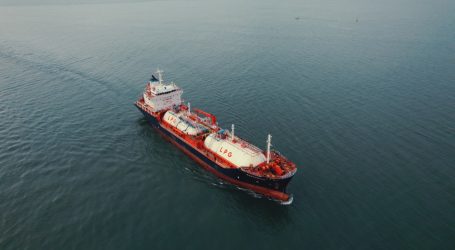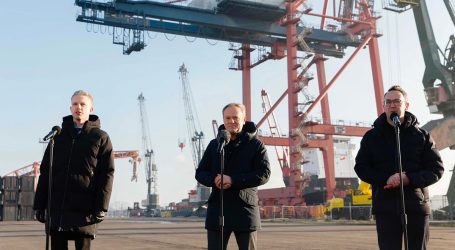18 tonnes per square metre – this is the weight of cargo that can be stored on new stacking yards at the Port of Gdynia Logistics Centre. The investment was exceptional from the outset, not least because of the speed at which it was built and the equipment used to carry it out.
Commissioned by the Port of Gdynia, a consortium of NDI Group companies built two manoeuvring and storage yards with concrete surfaces on the premises of the Logistics Centre. This is more than 17 hectares for storing containers and wind farm elements. The project also included the construction of linear drainage, underground and above-ground utilities, rainwater drainage networks, sanitary drainage networks, water mains, the so-called hydrant system together with a tank and a fire water pumping station. Power and telecommunications networks, two transformer stations, a storage reservoir with an access road and service platforms for refrigeration containers were also built.
– Almost 18 hectares of manoeuvring and storage yards at the Port of Gdynia are now ready for use. Demand for this space was very high prior to the investment, hence our great satisfaction that we can already make it available to our contractors. In an exceptional year for us – the 100th anniversary of the Port of Gdynia – we are completing another major investment, confirming that we are continuously building the future of the city, the economy and business – says Jacek Sadaj, President of the Management Board of the Port of Gdynia S.A.
In addition, an access road was built from Logistyczna Street. A total of 80.5 thousand m3 of concrete was used to construct the storage yards! The length of the expansion joints made is almost 70 kilometres.
– We are proud of this investment because, according to the contract, we were supposed to complete it in July 2022, and for the part of square No. 1 with an area of almost 30,100 m2, the decision on the permit for use was obtained already a year ahead of schedule, i.e. in July 2021. Meanwhile, for the remaining area of square No. 1 – another nearly 60,000 m2 – and for square No. 2 with an area of over 86,500 m2, the decision on the use permit was obtained in mid-March this year. We obtained the use of the fire road in the first half of June,” points out Sylwia Rogall, Project Director from the NDI Group.
1000 m3 of mix per day
What influenced such rapid progress of works? There are many factors, but as emphasised by Przemysław Młynarczyk, Site Manager with NDI, of considerable importance was the full involvement of the entire team and of the subcontractors and suppliers, and the fact that the surface works were often carried out around the clock without a break.
– This, of course, required appropriate logistical preparation and planning of the works in such a way that the material supply chain was not disrupted. The weather was also crucial, as concreting could only take place in favourable conditions, without precipitation. And it was the coordination of all these factors by the team that resulted in the increase of productivity in such a way that we managed to stay so far ahead of schedule,” assesses Przemysław Młynarczyk, Site Manager of the NDI Group.
Interestingly, a concrete batching plant was erected on the site, especially for this investment. Its achievable capacity is even 1000 m3 of mix per day.
The crane threw a 40-tonne load
In order for very heavy loads – up to 18 tonnes per square metre – to be stored on the stacking yards, the ground had to be reinforced. To do this, a huge crane was used, which dropped suitably shaped weights weighing between 10 and 40 tonnes from a height of 5 to 40 m. In this way, the shockwave compacted the weak subsoil.
This is not the only interesting technology used on this construction site. In addition to this, for example, the RDC (Roller Dynamic Compaction) was used, which was triangular, square or pentagonal in shape. With it, high-energy pulses were applied to the surface.
– It is also worth mentioning that the concrete was profiled to the preset height ordinate using specialised Somero-type machines with laser levelling strips profiling the pavement with an accuracy of a few millimetres,” reveals Przemysław Młynarczyk, construction manager with the NDI Group.
The value of this investment is over PLN 70.7 million net. New yards are an opportunity for the Port of Gdynia to develop and expand intermodal connections. This is especially important in the context of the role that Gdynia, a city on the map of the trans-European transport network, currently plays.
Source: PortalMorski.pl




